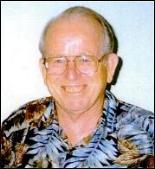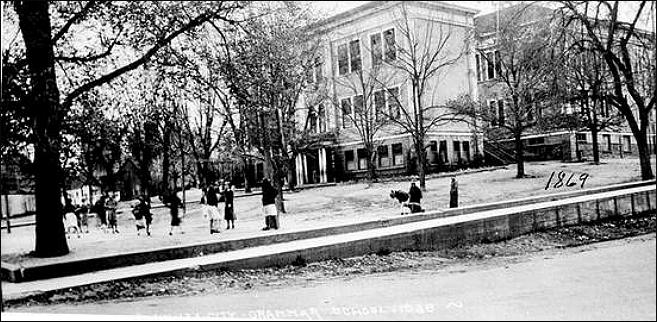Old Washington Grammar School
The "New" Elementary School
By Martin Keith Marsh

I entered first
grade at the old Washington Grammar School on 505 Maine
Street, Nevada City, in 1935. I had just turned 6, so I
don't have a profound recollection of the event. However, I
do know that my first grade teacher was Miss Gertrude Goyne,
a veteran teacher at Nevada City Elementary School. My Dad
often reminded us kids that Miss Goyne had taught him when
he was going to Washington School. Eventually, she taught
all four of us Marsh kids. (Mynola, Jean, Luther Jr., Keith,
and Germaine). Miss Goyne taught for 57 years, and was a
First Grade teacher in Nevada City for 52 years. Miss Goyne
has, to this day, a reputation for firmness.
Mrs.
Ruth Tamblyn Hooper, who was my teacher in both 3rd and 4th
grades, told me (Feb. 6, 1995) that she was assigned the
task of taking her little brother, Bob, to school on his
first day in Miss Goyne's class. There was a long line of
mothers, with children in hand, in front of the teacher's
desk awaiting introductions. Ruth was well down the line
with Bob when Miss Goyne looked up, stopped what she was
doing and called out something like, "Hasn't the little boy
in the back forgotten something?" Ruth had been a student of
Miss Goyne herself, and was very embarrassed that the
negligent lad who had his hat on indoors was little brother,
Bob! Everyone who had been taught by Miss Goyne came to
respect her as an outstanding teacher and a loving person.
Washington Grammar School was an imposing structure, at
least from the perspective of a 6-year old. But the building
was dilapidated, having been built in 1868, sixty-seven
years before my arrival on the scene. First graders aren't
expected to notice such things, and I was no exception. A
Morning Union newspaper editorial (October 1, 1935) of the
time described Grass Valley and Nevada City schools as
"inadequate as to space, unsanitary, and fire-trappish in
operative use." Enrollment was reported to be 420 students,
up from the 271 just four years earlier.
Elsie
Schreiber Sharpe was a member of the last eighth grade class
to graduate from Washington School. (Years later she taught
2nd grade at the "new" Nevada City Elementary School, became
principal, and after retirement, served on the Nevada School
Board). She has many recollections about the layout of the
school in its final years. Boy's and girl's lavatories were
located on the ground level in the back section of the
building. Girls had to go outside the building to gain
access, though the boys could enter their facility from the
inside. Ground floor, front, housed a manual training room
with work benches for the boys, a sewing room for the girls,
and furnace and custodial space. (Sewing and woodworking
training were required for the upper four grades in 1915,
but by 1936 the rooms received more limited use.)
On
the second floor were the office and grades 1 through 4.
Stairs and floors throughout the building were oil soaked
from the custodial practice of putting down oil-saturated
sawdust to facilitate sweeping. Elsie recalls that two steep
sets of stairs led up to the third floor, where grades 5
through 8 were located. Bells signaling the start and end of
the school day, recesses, fire drills, etc. were located in
4th and 8th grade classrooms. The two bells were operated
like door bells and functioned independently for the two
floors, since upper and lower grades ran on different
schedules. Dependable 4th and 8th grade pupils were selected
by the classroom teacher to ring the bells. According to
Elsie, it was a "big deal" when you were the one that got to
watch the clock and push the button when it was time for
recess.
A music room was also located in the front
section of the building, on the third floor. In Elsie's
words, "There was a stage and a place where you could seat
quite a few people." For emergency exit from the upper
floors there was a big wooden outside fire escape that came
down near Miss Goyne's first grade classroom out onto the
playground on the school street side. Nevada City firemen
considered the building to be a dangerous firetrap, and were
especially alarmed when they heard the fire bells signaling
a fire called in from the Cottage Street alarm box opposite
the school.
Nevertheless, I was proud to be attending
Washington School, the same one that both my Dad and
Grandfather had gone to, and which in its early years had
served Nevada City as a high school as well from 1877 to
1912. At the time of my matriculation, first grade was on
the second floor of the three-story building. The big kids
got the third floor classrooms. Miss Goyne sat at an
elevated desk that helped her oversee the class. The
platform on which her desk was situated had a handy corner
that proved to be the nemesis of misbehaving kids. Offenders
were summoned to the front of the class to sit there for a
period known only to the teacher; the punishment was more
embarrassing depending upon the disposition of the one being
disciplined. The 1st Grade Class of 1935-36.
Behind
the building there was a long, open but roofed over
structure...the lunch shed...that extended out across the
playground all the way to the fence line of the Searls
residence. The lunch shed divided the school yard into two
parts. On both sides of the divider were benches where kids
ate their lunches, visited, and horsed around. If you were
high enough in the kid pecking-order you might have had the
privilege of eating your lunch seated above the trash box at
the far playground end of the shed. Hard to believe in
today's reality is the fact that the girls were required to
play on one side of the divider, boys on the other.
Humiliating for first-grade boys was the fact that we were
required to play on the girl's side!
We neophyte
scholars were scarcely settled into this strange, new
structured environment of academia when it was announced
that we would be participating in a lantern parade through
the streets of downtown Nevada City. The purpose of the
parade was to demonstrate faculty and pupil support for
building a new elementary school, and it took place on
Friday night, October 4, a week before the school bond
election. Can you imagine today's school administrators
authorizing a lantern parade to support a school bond drive,
what with our over-zealous concern about liability suits?
Would it even be legal today?
I have a hazy memory of
marching in the parade...at least the forming up process on
York Street, which opens onto Broad Street just opposite to
what is now the City Hall. My Da was hovering around
somewhere close by amidst all the excited chattering, and he
handed me some kind of lantern just before the parade
commenced. My cousin, Dale Berger, close friend and
classmate through all 12 years of our schooling in Nevada
City, remembers getting dressed up as a "Chinaman" for the
occasion, along with our mutual friend and classmate, Andrew
"Andy" Chan. Andy's mother provided the costumes and put the
two boys up to wearing them in the parade. (The Chan's
operated the grocery store that was located just up the
street from the present location of the City Hall; they
lived in rooms over the store.)
According to the
Morning Union, the parade was a huge success, with the high
schoolers joining in to promote the passage of a
construction bond for additions to the Nevada City High
School. "Nearly all of them (the students) carried the old
time tin can lanterns, carbide lamps, or flashlights, and in
the elementary division one section wore miners 'hard-boiled
hats' with a banner stating they wore them to school 'to
protect our heads from falling plaster.''
Also
parading that evening were two women in a car with a sign
indicating that they had been members of the 1st first-grade
to pass through the "new" Washington School in 1868.
Although we didn't know it at the time, our first-grade
class was to be the last first grade to finish out the
school year at the old Washington School! Realize, of
course, that others can claim that their class was the last
1st grade class to attend Washington Grammar School, the
last class to graduate from Washington Grammar School, etc.
Whether or not the lantern parade influenced the
electorate, the school bonds passed, and construction
started on the new school in 1936. The building was financed
through the WPA. It cost $117,000, an early "matching funds"
project partially paid for by the federal government
($45,000) with a local bond issue ($72,000) covering the
remainder. The new structure, which exists today with minor
changes, was designed in the shape of the letter "L" so that
construction could proceed as classes continued in the old
building. It was built around the front and east side of
Washington Grammar School. Construction continued through
the fall term of 1936.
One cold, stormy morning,
right after we returned from the Christmas-New Year
vacation, Miss Savory Ford, our second grade teacher, had us
take our pencil boxes and other personal belongings out of
our desks and line up in the traditional column of twos for
the march to our new classroom in the new elementary school.
The Nevada City Nugget reported that the move to the new
school took place on January 4, 1937. Unfortunately about 50
students missed the event due to "heavy snow and bad
weather."
By the time the authorities got around to
dedicating the new school my class had progressed to the 3rd
grade. Not that I cared that much about it at the time.
Nevertheless, I have a related memory pertaining to the
event. It seems that Mrs. Marian Libby, the music teacher at
both elementary and high school, was putting together one of
her musical extravaganzas for the occasion. A group of 3rd
Graders was to participate, singing "Ten Pretty Girls at a
Village School," a popular ballad of the 1930's.
There were to be ten of our 3rd grade girls (including one
saucy little redhead) singing their lines while one boy
danced around...sort of flirting with the girls as he sang.
Woe was me when I found out that Mrs. Libby wanted me to
audition for the boy's part! I was certainly embarrassed
about all this, and didn't want my pals to know. And I guess
it showed. Bobby Cozzalio had to try out too. Bobby was
better looking, had a better voice, and...most important,
didn't have the hang-up about girls that I and most of our
buddies had at that age. At any rate, Bobby got the part and
I lived happily ever after...except in retrospect, as I
matured with age. (Incidentally, many years later Bobby
Cozzalio joined the U. S. Marines during our Junior year of
High School. He was killed in action in the Korean War
shortly after his unit landed to take part in the battle of
the Pusan Perimeter.)
Back

